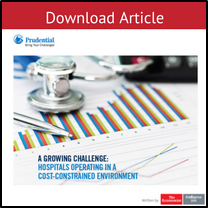Across the U.S., hospital executives are feeling pressure. Although growth rates in medical costs have slowed in recent years, hospitals now need to manage budgets within new payment contracts, such as value-based reimbursement and bundled payments. Unsurprisingly, then, an Economist Intelligence Unit (EIU) survey, sponsored by Prudential, revealed that costs are a dominant concern for hospitals and will shape business strategies in the years to come.
“The larger policy and payment environment has made cost—something that was already on their list—a priority,” says Ateev Mehrotra, Associate Professor in the Department of Health Care Policy at Harvard Medical School.
And when payments are tied to outcomes, the economic balance shifts. “Take a large health system like the one I work in—you had inpatient settings in the hospital, outpatient practices, radiology and all the other services. And the moneymaker was the hospital,” explains Professor Mehrotra, who is also a hospitalist at Beth Israel Deaconess Medical Center in Boston. “Now, so much pressure is on these health systems that it’s flipped around and the hospital has become the place where everyone wants to cut costs.”
The good news is that, from harnessing technology to maximizing staff capabilities, hospitals can adopt a number of measures to address their cost concerns.
Cost control sparks innovation
If necessity is the mother of invention, the crunch is driving hospitals to come up with new ways to contain costs. And hospital leaders are looking across their enterprises for savings.
When it comes to procurement, one area of focus is the purchase of implant devices, particularly for hip and knee replacements. Traditionally, surgeons have chosen their favored implant, resulting in small orders from many suppliers. “They now buy 50 of one type, so they have better negotiating power,” says Professor Mehrotra.
Hospitals are also reviewing staffing expenditure. While competition for talent makes it hard to lower base pay, combining remuneration with flexible working and other quality-of-life benefits helps contain costs while giving hospitals a competitive edge in attracting skilled staff.
Another staffing efficiency is “top-of-license” nursing, where non-nursing tasks are delegated to support staff. “If you can have a nurse practitioner in a critical access hospital operating at the top of his or her license instead of having a physician there, that’s going to save a considerable amount of money and address a staff shortage,” says Chris Steel, Head of the U.S. healthcare practice at PA Consulting Group and Global Head of Healthcare at the firm.
Better care, lower cost
Many survey respondents believe that to benefit from economies of scale, they will embark on mergers and acquisitions or informal partnerships. And in some cases, these new models not only reduce costs but also improve care quality.
This includes a form of consolidation referred to as “factories of care.” Rather than patients going to one venue to see their physician, another to visit the surgeon and another for an MRI or to undergo lab tests, many hospitals are bringing these services together.
“You’ve got better collaboration and faster-moving processes and thus reduced costs,” says Mr. Steel. “That’s an approach being adopted with the added advantage that it’s better for patients,” he says.
Another cost efficiency that improves quality of care is reduced hospitalization, which is incentivized by new payment models. “Research has highlighted that individual physicians and hospitals with the same patients can have hospitalization rates that vary quite a bit,” says Professor Mehrotra. “But if you can shift hospitalization down, you can decrease spending.”
This means making better decisions on whether to admit a patient to the hospital after he or she arrives at the emergency room. Patients are frequently admitted because they lack care at home. The solution is to find them better options. “Some hospitals have created the infrastructure within the emergency department to send the patient to a skilled nursing facility when they don’t need hospitalization,” says Professor Mehrotra.
Technology drives efficiencies
For a hospital CEO, decisions on technology investments are not easy. While technologies such as electronic health records are critical in improving care quality, and digital technologies increase operational efficiencies, it can be difficult to put a dollar figure on savings associated with these technologies.
In hospital administration, the challenge is that moving from paper-based to digital systems does not immediately cut costs but requires investment. “Now you have a huge line item in the budget for IT,” says Professor Mehrotra.
This is the case with analytics, which requires investments in software that can harness computing to glean insights from large amounts of data. For the largest group of respondents, cost is a barrier to making better use of analytics.
The expansion of IT in hospital settings also requires an investment in human resources—creating positions that some employers are struggling to fill. In a recent survey by the Healthcare Information and Management Systems Society (HIMSS), only 32% of health IT employers said they were fully staffed, suggesting strong demand for health IT workers.
Remote care extends services
When it comes to clinical operations, telemedicine—the diagnosis and treatment of patients remotely via communications technologies—helps improve the bottom line. The technology allows smaller or rural hospitals to justify hiring specialists to maintain a full range of services. An example is the case of a patient who has had a stroke, where an immediate decision needs to be made as to whether to inject him or her with tissue plasminogen activator to dissolve the clot. Hospitals that cannot afford a full-time neurologist can contract with companies that have a staff neurologist who can make that decision remotely.
The telemedicine model also cuts the cost of other hospital functions, such as the pharmacy. With an e-pharmacy service, a central hub is staffed with licensed pharmacists who create and approve the labeling. The drugs are then dispensed locally. “Telehealth and other virtual solutions are only viable as long as there’s a clear path to return on investment,” says Mr. Steel. “And with e-pharmacy, there is that path.”
New payment models will strengthen the business case for telemedicine. “One of the blockers in bringing in virtual technologies has not been technology itself but the fact that it’s been hard to get reimbursed for the consultations,” says Mr. Steel. “That’s changing in many states.”
Meanwhile, in the drive to reduce hospitalization rates, telemedicine also plays a key role. Patients equipped with sensors and mobile devices can have their vital health signs monitored from home rather than in a hospital, with the readings transmitted to a clinician who can make decisions about potential medical interventions.
While virtual healthcare may have an immediate payback, hard evidence of the technology-driven savings on administrative costs has yet to emerge. But for those prepared to take the long view, technology can drive efficiencies that ultimately improve the balance sheet. And in many cases, these innovations can also increase quality of care.
Source1Healthcare Information and Management Systems Society, “HIMSS Leadership and Workforce Survey Shows Health IT Continues as ‘Bright Spot’ in Economy,” February 21, 2017, http://www.himss.org/news/new-himss-leadership-and-workforce-survey-notes-health-it-continuesbright-spot-economy-even-ehr








